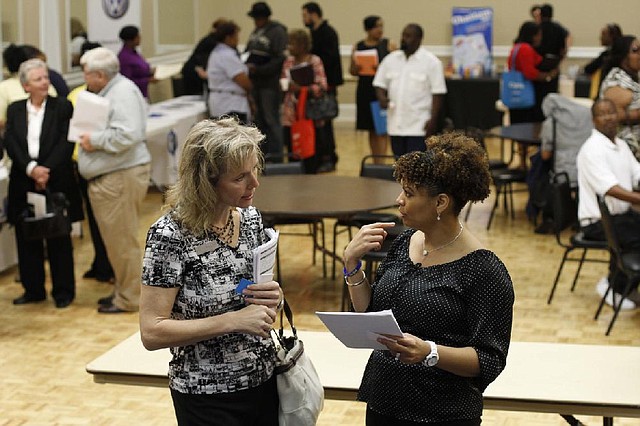Jobless-aid claims hit 5-year low
Weekly applications fall by 18,000, Labor Department says
Donna Van Natten (left), with the Enterprise Center, and Valoria Armstrong, with Tennessee American Water Co., talk Tuesday during a job fair in Chattanooga, Tenn. Weekly applications for unemployment benefits fell 18,000 last week, the Labor Department said.
Friday, May 3, 2013
WASHINGTON - The number of Americans seeking unemployment aid fell last week to a seasonally adjusted annual rate of 324,000, the lowest since January 2008.
The Labor Department said Thursday that weekly applications fell 18,000, the second-straight sharp drop. The four-week average, a less volatile measure, fell 16,000 to 342,250, close to a five-year low.
Applications are a proxy for layoffs. When they fall below 350,000, it is generally consistent with moderate hiring.
But layoffs are only half the equation: Companies also need to be confident enough to add workers for job growth to pick up and lower the unemployment rate. Many have held off adding workers in recent months, possibly because of concerns about the effect of federal spending cuts and tax increases.
Economists forecast that the economy added 160,000 jobs last month. That’s much better than the 88,000 added in March, but below last year’s pace of nearly 185,000 per month. The unemployment rate is expected to remain unchanged at 7.6 percent.
But many economists have lowered their estimates this week, some as low as 120,000, after several reports suggested that slower growth is dragging down hiring. The government will release the April employment report today.
The spending cuts, known as sequestration, and higher Social Security taxes may be making businesses more cautious about hiring, economists say. And the tax increase could slow consumer spending. The Federal Reserve said Wednesday that those policies are “restraining economic growth.”
“We think hiring will be more subdued in the second quarter as the economy weathers a consumer-spending slowdown and sequestration job cuts,” said Julia Coronado, an economist at BNP Paribas. Unemployment-benefit applications “will not capture either of these developments.”One reason layoffs may not rise is that federal agencies are cutting hours, rather than jobs.
The data ahead of today’s jobs report have been discouraging. On Wednesday, payroll provider ADP said companies added just 119,000 jobs in April. And a survey of manufacturers by the Institute for Supply Management found that a measure of employment fell sharply last month.
Many companies have been advertising more jobs but have been slow to fill them. Job openings jumped 11 percent during the 12 months that ended in February, but the number of people hired declined, according to a Labor Department report last month.
Nearly 5 million people received unemployment aid during the week ended April 13, the latest data available. That’s down from nearly 5.1 million in the previous week.
Still, consumers are more optimistic that the job market is healing and will deliver higher pay later this year, according to a survey of April consumer confidence released this week. And lower gasoline prices could offset some of the pinch from the tax increase.
The economy grew at an annual rate of 2.5 percent from January through March, the government said last week.
That was an improvement from the anemic growth of 0.4 percent in the final three months of last year. Most economists expect growth will slow in the current quarter to 2 percent or lower.
Business, Pages 29 on 05/03/2013
